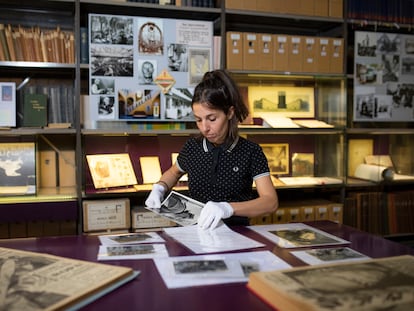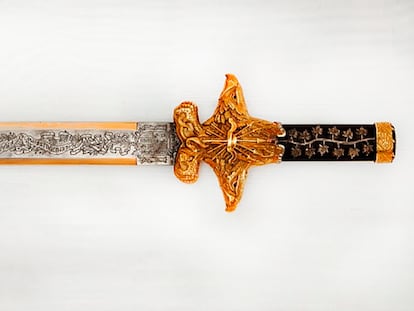Franco’s tyranny against railroad workers
A new website and documentary reveal how the dictatorship targeted its enemies in this sector, with many imprisoned, sent into exile and executed

In 2011, a team of forensic anthropologists uncovered a 30-meter-long chain of graves in Gumiel de Izán, Burgos. Due to the profession of most of the 59 victims buried there, the place was dubbed “the railroad workers’ grave.” They had been murdered by squads of the fascist party Falange in 1936 and buried by street sweepers from Aranda de Duero. Ten years on, Public Works Minister José Luis Ábalos and the president of Spain’s state-owned railway operator Renfe, Isaías Táboas, have set up a website –www.memoriahistoricaferroivaria.org – and released a film called, Los hijos del hierro (or The children of steel) which documents the tyranny of the Francisco Franco dictatorship towards its enemies forced to work in this sector.
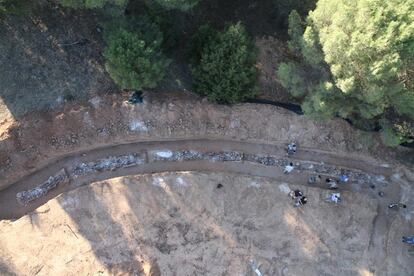
Eighty-eight percent of the rail workforce, amounting to around 90,000 people, were targeted by purging committees. The Franco regime went so far as to create a specific police force that infiltrated companies in order to spy on the railroad workers and detect possible enemies. “The objective,” explains historian Miguel Muñoz, author of several investigations on repression in the sector, was “to annihilate the unions and place the workers in a situation of permanent terror.” Those suspected of being enemies of the regime were not only removed from their trade, but also murdered, executed after being sentenced to death, imprisoned, used as slave labor and forced into exile. The website contains an exhaustive database with files on the reprisals, including those against at least 4,592 women. The film, which can be seen on Renfe’s YouTube channel, takes its title from a piece of writing poet Miguel Hernández published, under a pseudonym, in 1937 as a tribute to the railway workers.
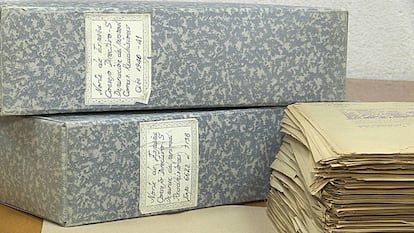
Researchers Francisco Polo, Miguel Muñoz, Fernando Mendiola and Carlos Hernández all participated in the documentary, explaining the multiple methods of repression used by the Franco regime against railway workers such as Antonio Sin, José Báscones, Luis Miguel Martín Montoliu, Paqui Chaves or the former coach of Spain’s national soccer team, Vicente del Bosque, as well as their relatives.
Flavio Báscones worked as a brakeman for the Railway Company. He was a member of both the UGT union and the Spanish Socialist Party (PSOE) and had been elected mayor in Mataporquera, Cantabria. The website states that during the Spanish Civil War (1936-39) he dug trenches and fought to defend his town, but finally had to go into exile in France with his family, where he remained until his death. His son José remembers his journey into exile from Matarporquera to Ribadesella and from there to Gijón: “They bombed the cinema where we had taken refuge, we couldn’t breathe from the dust,” he recalls. Then to Bordeaux, by train to Girona where, he says “we ate lettuce that we picked from the vegetable plots, pine nuts from the pine forests;” then to Lloret del Mar, and from there to Paris and to the Belgian city of Liège, where he was reunited with his parents in March 1940, before settling definitively in France to live through his second war. “That generation suffered a lot,” says Vicente del Bosque whose father, Fermín – also a railway worker – was imprisoned in Salamanca and Vitoria.
Francisco Chaves was murdered in Torremejía. “He was a track and works foreman,” says his granddaughter Paqui. “The Francoists took him and killed him. They shot him and left him lying in a ditch. There was no trial. His death certificate says ‘Dead due to the war’.”
Antonio Sin was sentenced to death. He spent eight months waiting for his execution, recalls his son Antonio. After eight months, the sentence was commuted in exchange for agreeing to a transfer to the Bustarviejo penal colony in Madrid, where he worked, with almost 1,000 other prisoners on the Madrid-Burgos railroad. The families of many inmates settled right across the street, in stone shacks they built themselves. “That was our home, in the countryside,” says Antonio. His mother, who was a teacher, taught the children of the other prisoners.

The penal colonies were always located near large construction sites and it was the bosses of the contracting companies themselves who went to the prisons to select the healthiest, strongest workers. When they were released, many of the prisoners continued working for the same company because their sentences always included an order of exile, meaning they could not return to their homes. Antonio Sin was among those who continued working on the lines.
From 1938, prisoners of war and political prisoners were used in various railway works to repair what had been destroyed by the war or to build new infrastructure. Until 1940, the number of forced laborers exceeded 9,000. During the last months of the Spanish Civil War, railroad work accounted for 7.1% of the work done by prisoners. The numbers remained close to 3,000 until 1945; during the 1950s, they dropped to below 500.
A team of archaeologists led by Alfredo Ruibal from the Spanish National Research Council (CSIC) excavated the Bustarviejo penal colony in 2007 to document the lives of the prisoners and their families. The complex has now been restored and set up as a place of memory.
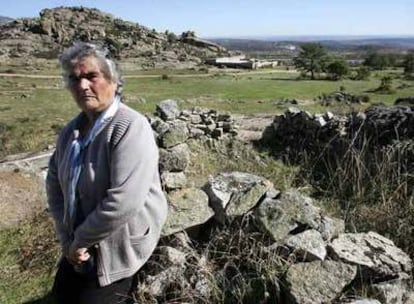
“We tried to close a dark chapter in our history too quickly… We were wrong”
The Transition from the Franco dictatorship to democracy was criticized by Public Works Minister José Luis Ábalos at the presentation of the new website and documentary. “Memory hurts, but it is healing,” he said. “Certain sectors, whose link with fascism we must not stop denouncing, continue to rebel against it. Repression is not the worst legacy of terrible dictatorships such as the one we were subjected to. What really annihilates us as a society is oblivion and silence. The political reasons for this do not escape us. We tried to close a dark chapter in our history too quickly in order to embrace democracy. We naively believed that reconciliation meant not looking back, but we were wrong. In order to avoid seeing the open wounds, we were unjust. It is only by examining the past that we will be able to have a dignified future. This is the main lesson we have learned. It is time for the victims of Francoism and their families to stop footing the bills for our democracy.”
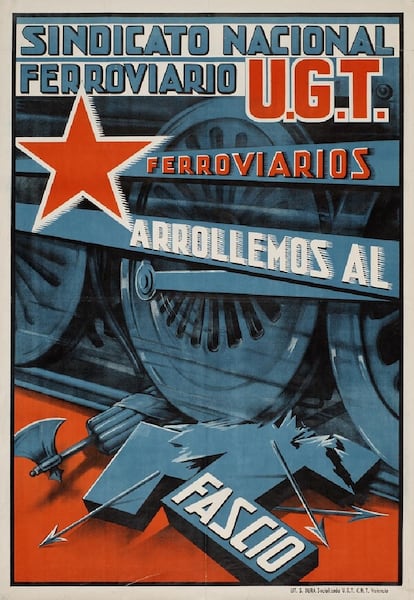
Describing “the children of steel” in his 1937 book, poet Miguel Hernández wrote: “Greased and muscular as axles or engines, they carry traces of smoke on their foreheads, and on their skin the pure footprints that work leaves with its powerful horse hooves. They look like burnt ore, running through loyal Spain from end to end, heroic and swift under enemy bombardment. Their muscles tremble like machines, and like machines they do not mind rolling relentlessly through these days in which the freedom of Spain depends on the effort of every Spaniard.”
English version by Heather Galloway.
Tu suscripción se está usando en otro dispositivo
¿Quieres añadir otro usuario a tu suscripción?
Si continúas leyendo en este dispositivo, no se podrá leer en el otro.
FlechaTu suscripción se está usando en otro dispositivo y solo puedes acceder a EL PAÍS desde un dispositivo a la vez.
Si quieres compartir tu cuenta, cambia tu suscripción a la modalidad Premium, así podrás añadir otro usuario. Cada uno accederá con su propia cuenta de email, lo que os permitirá personalizar vuestra experiencia en EL PAÍS.
¿Tienes una suscripción de empresa? Accede aquí para contratar más cuentas.
En el caso de no saber quién está usando tu cuenta, te recomendamos cambiar tu contraseña aquí.
Si decides continuar compartiendo tu cuenta, este mensaje se mostrará en tu dispositivo y en el de la otra persona que está usando tu cuenta de forma indefinida, afectando a tu experiencia de lectura. Puedes consultar aquí los términos y condiciones de la suscripción digital.
More information
Últimas noticias
Maduro pleads not guilty before the federal court in New York: ‘I am still the president of Venezuela’
A new test can detect Alzheimer’s from a finger prick
UN team enters Sudanese city of El Fasher after paramilitary massacre: ‘It’s like a ghost town’
A recipe for resistance: Indigenous peoples politicize their struggles from the kitchen
Most viewed
- Gilles Lipovetsky: ‘If you want to live better and fall in love, take Prozac, don’t look to philosophy’
- Alain Aspect, Nobel laureate in physics: ‘Einstein was so smart that he would have had to recognize quantum entanglement’
- Alvin Hellerstein, a 92-year-old judge appointed by Bill Clinton, to preside over Maduro’s trial in New York
- Why oil has been at the center of Venezuela-US conflicts for decades
- Cuba confirms death of 32 of its citizens in the US attack against Venezuela

